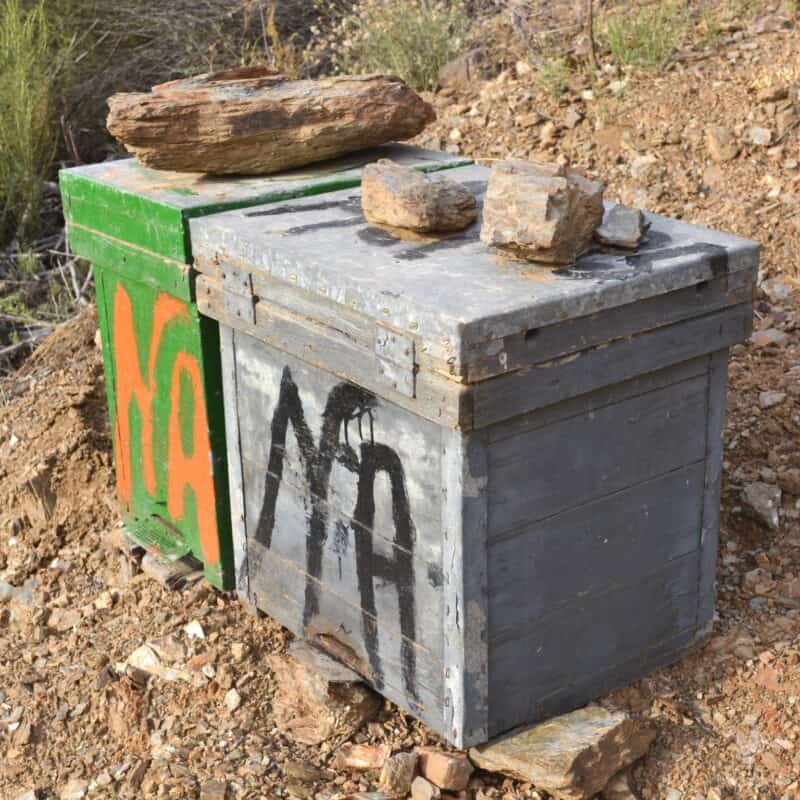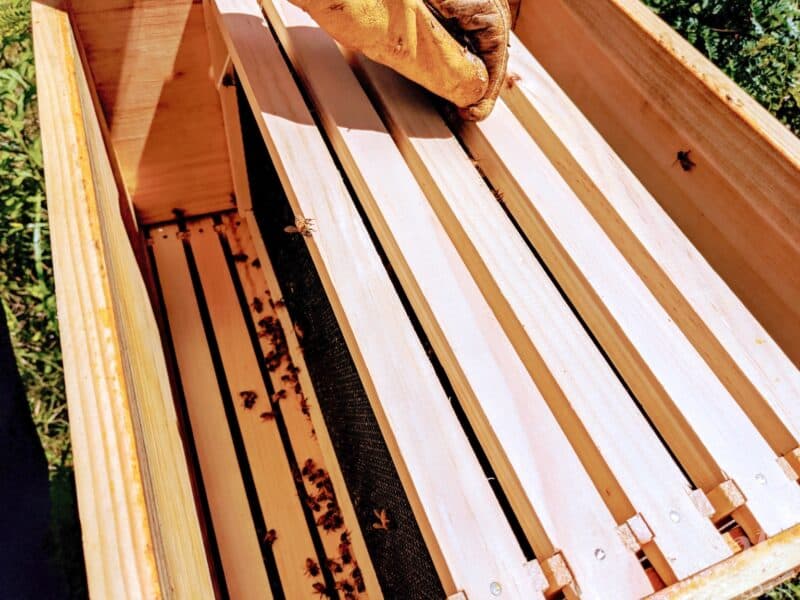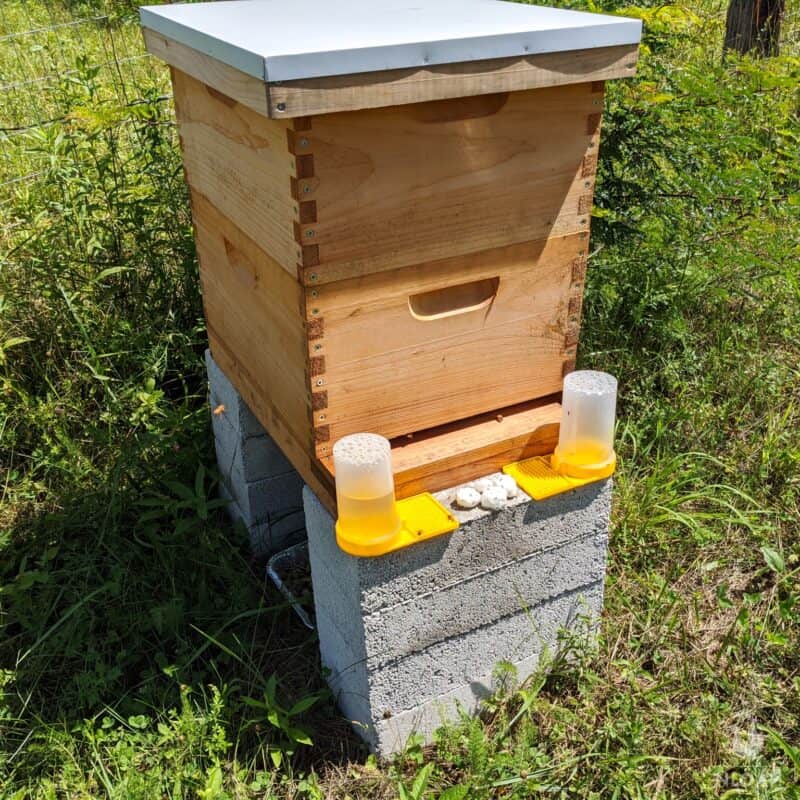Bees are among the most amazing builders in nature. Given just a little bit of time, they’ll soon construct a tidy, orderly hive containing hundreds and hundreds of cells used for storing honey and hatching the next generation of bees.

They are amazingly adaptible to different environments and different circumstances when they decide to set up shop. But that brings up an interesting question: what are beehives made of?
Beehives found in nature are made of wax and propolis, a resinous substance that seals the hive and acts as a foundation. Modern, man-made beehives are typically made of wood and may have plastic components.
As intricate and amazing as they are, there aren’t too many materials that go into making a highly effective, safe and cozy hive for bees.
Even man-made hives are the picture of simplicity, being a little more than wooden crates with slide-out frames that might have a plastic component here and there.
But despite being made from few materials, beehives can be incredibly intricate.
Keep reading, and I’ll tell you everything you ever wanted to know about the things that beehives are made from…
Most Natural Hives are Built in Nooks and Crannies
Most beehives are enclosed, meaning they aren’t just built dangling off of a branch or some other convenient surface, although some of them are.
Most species of wild bees tend to build hives inside an opening or space that can give them protection from sun, rain, and predators alike.
Usually this will take the form of a hollow in a live or dead tree, or sometimes a crack or crevice in a rock face.
Most honey bees prefer to build up off of the ground a little ways, and each species has its own preference when it comes to the overall size of the space that will be there new home.
Regardless of the overall size, bees will always outfit it to their purposes using wax and propolis, two substances that the bees make themselves.
Bees Make Wax Themselves for Most Hive Construction
Bees make beeswax to form their hives. Pretty much everybody knows that! But the process of producing beeswax is seriously fascinating.
Beeswax is made by worker bees, and they are equipped to produce wax once they fully mature at around 10 weeks of age.
The worker bees consume nectar and turn it into honey, and then use a special gland in their abdomen to process the sugars from the honey to convert it into wax.
This wax is then actually secreted through special pores in the abdomen of the bee, and you can see it yourself as it appears; it usually looks like small flakes or bits of wax on their behind.
Bees then mold the wax and soften it by chewing on it before placing it where it is needed and forming it into a cell.
The cell is the basic multi-purpose storage unit of the beehive, used for stashing honey and laying eggs alike.
The hexagonal shape of the cell is not only extraordinarily efficient when it comes to the use of wax but it is also very strong, lending strength to the hive itself.

Bees also Make Propolis from Wax and Plant Resins
But before bees lay down wax to start forming cells in the honeycomb, they foundation to build from. This is where propolis comes in.
Propolis is similar to wax, and is made with a little bit of wax, but it isn’t simply wax. Instead, propolis is dense, sticky shellac-like substance, one that is laid down as the foundation of the hive that the bees will build on.
It is also used as a sort of doormat at the entrance of the hive to make it easier for bees to come and go while cleaning their feet of potential contaminants.
Workers also make the propolis, and it’s typically fashioned from a little bit of beeswax with various collected plant resins that are typically taken from young or budding plants.
Mixed in with a little bit of bee saliva and chewed to the right consistency, pretty soon they have propolis to lay down.
Propolis also serves to seal up the hive to prevent the intrusion of moisture and also predators or parasites that might try to sneak in by some way other than the front entrance.

Man-Made Beehives are Typically Crafted from Wood
Of course, many bees today are domesticated, or as domesticated as any insect can be, and they live inside man-made beehives.
There are several modern designs that are intended to allow beekeepers to extract honey without harming their bees or disrupting their home, a distinct advantage compared to historical designs.
But whether someone is dealing with a top-bar hive, a Langstroth hive or a Warre hive, they’re all typically made of wood.
What wood is best for making beehives is a subject of considerable debate, but most kinds of wood will do and are not harmful for the bees so long as they afford good weather resistance.
Remember, the bees are still going to be living outside pretty much the entire time!
Some components of a modern beehive may also be made from plastic, typically the cross members in a frame that the bees will begin to build on, but many are still made entirely of wood.
But once the bees are inside, they resort to building in the way that they know best: with wax!
Traditional Beehives Were Made from All Kinds of Different Things
Beehives weren’t always made from wood for domesticated bees. You might be surprised to learn just how many different kinds of materials were used for making them!
Among them, hives would have been woven from grasses or wicker and sometimes plastered with mud, forming a coil-shaped beehive that looks a little bit like a conical seashell.
Other cultures depended on clay for all kinds of building and architectural purposes, and that includes beehives.
Some ancient clay beehive setups used throughout Mediterranean countries long ago would be designed to nest together they series of interlocking passageways that would allow beekeepers to shoo bees from one to the other so that they could collect honey safely.
And there were also beehives made entirely from mud, or a mixture of mud, dung and other materials like grasses or straw.
Much like building a mud hut, these beehive structures could be adapted into nearly any size and shape imaginable depending on requirements.
Tom has lived and worked on farms and homesteads from the Carolinas to Kentucky and beyond. He is passionate about helping people prepare for tough times by embracing lifestyles of self-sufficiency.
